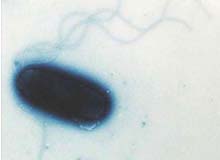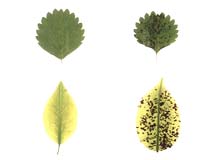Genetic Engineering
Analyses of pathogenicity and virulence factors in plant pathogens and their application to plant disease resistance
Staff
 | Prof. Dr. ICHINOSE Yuki E-mail: yuki (please add @okayama-u.ac.jp) Specialty: Molecular Plant Pathology Analyses of pathogenicity and virulence factors in plant pathogenic bacteria and their application to plant disease resistance |
 | Assoc. Prof. Dr. MATSUI Hidenori E-mail: hmatsui (please add @okayama-u.ac.jp) Specialty: Plant Pathology, Plant Physiology Analyses of plant immune regulators and their application to plant breeding for disease resistance |
Research Topics
It is important to reveal pathogenicity and virulence factors in plant pathogens and plant immune response for effective control of plant disease. We investigate pathogenicity- and virulence-related genes of plant pathogens and molecular mechanisms of plant disease resistance by molecular and genetic approaches.
Analyses of pathogenicity and virulence factors in plant pathogenic bacteria

・Pseudomonas syringae is a representative Gram-negative plant pathogenic bacterium that has been isolated from a wide variety of plant species. It can be classified into at least 50 pathogenic variants (pathovars), which vary in host range and type of disease symptoms. To establish infection and incite disease development, bacteria first have to enter a plant. This process requires flagella- and type IV pili-mediated motility. After bacteria enter a plant’s apoplastic spaces, they need to overcome host plant resistance through the secretion of a wide variety of hypersensitive response and pathogenicity (Hrp) effector proteins into the plant cytoplasm to interfere with pathogen/microbe-associated molecular pattern- and effector-triggered immunity. P. syringae produces phytotoxins and/or phytohormones to suppress plant defense responses and extracellular polysaccharides to prevent access by antibiotics and to chelate Ca2+, and activate the multidrug resistance efflux pump to extrude antimicrobial compounds for successful colonization. Furthermore, bacterial phytotoxins and Hrp effectors compromise a plant’s homeostasis and injure plant cells. The expression of these virulence factors depends on the infection processes and environmental conditions. We study and elucidate the complex networks in the regulation of bacterial virulence-related genes.
・Bacterial wilt caused by Ralstonia solanacearum is one of most severe diseases in solanaceous crops. It reduces crop production in major and important solanaceous crops, such as potato, tomato, eggplant, and peppers. R. solanacearum is one of most difficult pathogens to control, and it is well known that this bacterium secretes a large amount of exopolysaccharide which interferes with water supply to upper leaves, and causes wilt symptoms. The Hrp type III secretion system is also an important pathogenicity factor for disease development. R. solanacearum directly translocates 72 effector proteins into plant cytoplasm. If bacterium translocates effectors into compatible host plant, effectors interfere with normal plant physiology to cause disease symptoms, whereas the bacterium translocates effectors into incompatible host or nonhost plants, effectors will be recognized by some plant receptors. In the latter case, plants express a strong and rapid defense response, and infection will fail. We study the molecular mechanisms of bacterial virulence and corresponding plant responses.
Analyses of pathogenicity factors in plant pathogenic fungi, Alternaria alternata

・A. alternata is generally a saprophyte or a weak pathogen of plants but certain groups of this species have pathogenicity on specific plant cultivars while they cannot affect other cultivars in a plant species. These specificity are controlled by combinations of host specific toxins (HST) produced by the pathogen and sensitivity of cultivars to the toxins. So far, 7 HST-producing A. alternata were reported and distinguished by pathotype classification, for example, the pathogen of Morioka 16 in strawberry is described as the strawberry pathotype of A. alternata.
・The genetic backgrounds of genes involved in HST biosynthesis are one of our research projects. Interestingly, revealed gene clusters of each pathotype positioned in small, extra-chromosome which is dispensable in saprophytic lifecycle of the pathogens. Thus, chromosomes contain HST biosynthesis gene clusters are conditionally dispensable chromosomes (CD chromosomes). Recently, we have identified 8th HST- producing A. alternata from peach. Chemical characterization of the toxin and identification of the genes involved in HST biosynthesis are in progress.
・The genetic backgrounds of genes involved in sensitivity to HST are another research project. Development of a DNA maker linked to gene(s) for HST sensitivity has started by using NGS data.
Publications
・Nahar, K., Matsumoto, I., Taguchi, F., Inagaki, Y., Yamamoto, M., Toyoda, K., Shiraishi, T., Ichinose, Y. and Mukaihara, T. (2014) Ralstonia solanacearum type III secretion system effector Rip36 induces hypersensitive response in the nonhost wild eggplant Solanum torvum. Mol. Plant Pathol. 15 (3): 297-303. DOI: 10.1111/mpp.12079
・Ichinose Y, Taguchi F, Mukaihara T (2013) Pathogenicity and virulence factors of Pseudomonas syringae. J. Gen. Plant Pathol. 79 (5) 285-296.
・Taguchi, F. and Ichinose, Y. (2013) Virulence factor regulator (Vfr) controls virulence-associated phenotypes in Pseudomonas syringae pv. tabaci 6605 by a quorum sensing-independent mechanism. Mol. Plant Pathol. 14 (3) 279-292.
・Ichinose, Y., Taguchi, F., Yamamoto, M., Ohnishi-Kameyama, M., Atsumi, T., Iwaki, M., Manabe, H., Kumagai, M., Nguyen, Q. T., Nguyen, C. L., Inagaki, Y., Ono, H., Chiku, K., Ishii, T. and Yoshida, M. (2013) Flagellin glycosylation is ubiquitous in a broad range of phytopathogenic bacteria. J. Gen. Plant Pathol. 79 (5): 359-365.
・Kawakita, Y., Taguchi, F., Inagaki, Y., Toyoda, K., Shiraishi, T. and Ichinose, Y. (2012) Characterization of each aefR and mexT mutant in Pseudomonas syringae pv. tabaci 6605. Mol. Genet. Genomics 287: 473-484.
・Nguyen, L.C., Taguchi, F., Tran Q.M., Naito, K., Yamamoto, M., Ohnishi-Kameyama, M., Ono, H., Yoshida, M. Chiku, K., Ishii, T. Inagaki, Y., Toyoda, K., Shiraishi, T. and Ichinose, Y. (2012) Type IV pilin is glycosylated in Pseudomonas syringae pv. tabaci 6605 and required for surface motility and virulence. Mol. Plant Pathol. 13 (7): 764-774.